Kashi Vishwanath Temple
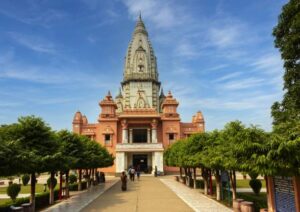
The Kashi Vishwanath Temple in Varanasi is one of India’s most sacred shrines, dedicated to Lord Shiva. Revered as a Jyotirlinga, it symbolizes spiritual liberation. The temple’s origins date back centuries, with the current structure rebuilt by Maharani Ahilyabai Holkar in 1780. Maharaja Ranjit Singh later adorned its dome with gold, earning it the title ‘Golden Temple of Varanasi.’
Architecturally stunning, the temple’s golden spire and intricate carvings reflect its grandeur. Devotees gather for daily aartis, offering prayers at the revered Shiva Linga. Festivals like Mahashivratri and Dev Deepawali transform the temple into a hub of devotion and celebration.
A visit to Kashi Vishwanath Temple is a divine experience, filling devotees with peace and enlightenment. It stands as a beacon of faith, drawing millions seeking spiritual bliss. Have you visited this sacred site? Share your experience and let the essence of Kashi inspire others.
Historical Legacy of Kashi Vishwanath Temple
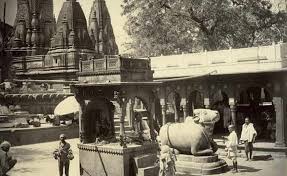
The Kashi Vishwanath Temple, dedicated to Lord Shiva, is one of the most revered shrines in Hinduism. Located in Varanasi, one of the world’s oldest living cities, the temple has been a center of spiritual devotion for centuries. Its history is marked by numerous destructions and reconstructions, symbolizing the unwavering faith of devotees.
Ancient References
The Kashi Vishwanath Temple has deep roots in Hindu mythology and ancient scriptures.
- Skanda Purana: Describes Kashi (Varanasi) as the most sacred city, stating that a visit to the temple grants spiritual liberation (moksha).
- Shiva Purana: Mentions that Lord Shiva declared Kashi as his eternal abode, making it one of the holiest places for Hindus.
- Mahabharata and Ramayana: Indirect references suggest that Varanasi and its Shiva temple existed during the epic periods.
Hindus believe that dying in Kashi, especially after visiting Vishwanath, ensures liberation from the cycle of rebirth.
Medieval Destruction and Reconstruction
The temple’s history has been shaped by a cycle of destruction and revival:
- Qutb-ud-din Aibak (12th Century): The temple was first demolished under his rule, but Hindu kings later rebuilt it.
- Iltutmish (13th Century): Another wave of destruction occurred, yet worship at the site continued.
- Mughal Emperor Aurangzeb (1669): Ordered the temple’s destruction and replaced it with the Gyanvapi Mosque. Devotees, however, continued their prayers in secret. The original Shiva Linga was said to have been hidden in the Gyanvapi Well, which still exists today.
Despite these challenges, the spirit of devotion remained unbroken, and efforts to rebuild the temple continued.
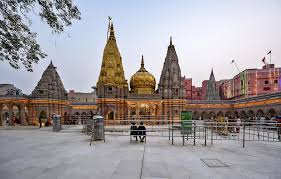
Modern Rebuilding and Contributions
After centuries of destruction, the temple was rebuilt in its present form in 1780 by Maharani Ahilyabai Holkar of Indore, a devout Hindu queen. Her contribution restored the temple’s status as a major pilgrimage center.
Other notable contributions include:
- Maharaja Ranjit Singh of Punjab (1839): Donated one ton of gold to cover the temple’s dome, giving it its distinctive golden appearance.
- Nepali King Contribution: The Nepalese King donated the Gauri Shankar Temple, also known as the Nepali Temple, near Kashi Vishwanath.
- Scindia Family Contributions: Continued restoration efforts to preserve the temple’s grandeur.
The present-day temple structure stands as a testament to faith and perseverance, drawing millions of devotees every year.
Recent Developments: Kashi Vishwanath Corridor Project (2021)
The Kashi Vishwanath Corridor Project, inaugurated in 2021, has transformed the temple complex.
Key Highlights of the Project:
- Improved accessibility: The temple is now directly connected to the Ganga River through a grand corridor.
- Expanded premises: Several old buildings were restored to create a more spacious complex.
- Enhanced facilities: New pathways, waiting areas, and amenities have made pilgrimage easier and more comfortable for devotees.
- Conservation efforts: The project preserved historical structures while modernizing the surroundings.
Mythology and Spiritual Significance
The Legend of Lord Shiva’s Eternal Abode
According to Hindu mythology, Lord Shiva himself declared Kashi as his permanent residence. It is believed that those who die in Varanasi, especially after visiting Kashi Vishwanath Temple, attain moksha (liberation) and are freed from the cycle of birth and death.
The Jyotirlinga of Kashi Vishwanath
Kashi Vishwanath is one of the twelve Jyotirlingas, sacred representations of Lord Shiva. As per scriptures, the light of this Jyotirlinga is self-manifested and holds supreme spiritual energy.
Connection to Ganga and Moksha
The temple is closely associated with the Ganga River, which is believed to have descended from Lord Shiva’s locks. Pilgrims take a dip in the holy Ganges before offering prayers at the temple to cleanse their sins.
Architectural Grandeur of Kashi Vishwanath Temple
The temple is an architectural masterpiece with a unique blend of spirituality and artistry.
Temple Structure and Design
- The temple follows the Nagara style of architecture, characterized by a towering spire (shikhara), intricate carvings, and a sanctum (garbhagriha).
- The main sanctum houses the revered Shiva Linga, which is bathed in milk, water, and honey as part of daily rituals.
- The temple’s golden dome, plated with 800 kg of gold, glows magnificently under the sun, adding to its divine charm.
Sacred Shrines Within the Complex
Apart from the main sanctum, the temple complex houses multiple shrines dedicated to different deities, including Mata Annapurna, Lord Ganesha, and Lord Kaal Bhairav.
Daily Rituals and Worship Practices at Kashi Vishwanath Temple
The Kashi Vishwanath Temple follows a meticulously structured schedule of daily rituals, aartis, and special poojas, offering devotees a divine and immersive spiritual experience. The rituals are performed with great devotion, invoking Lord Shiva’s blessings for the well-being of all.
Daily Worship Schedule & Major Rituals
| Ritual / Worship | Timing | Significance |
|---|---|---|
| Mangala Aarti 🌄 | 3:00 AM – 4:00 AM | First aarti of the day, welcoming Lord Shiva with hymns and prayers. |
| Sarva Darshan (General Darshan) 🙏 | 4:00 AM – 11:00 AM | Devotees can have darshan of the Jyotirlinga. |
| Bhog Aarti 🍲 | 11:30 AM – 12:00 PM | Offering of food (bhog) to Lord Shiva as an expression of gratitude. |
| Temple Rest Period | 12:20 PM – 1:00 PM | The temple remains closed for a short break. |
| Afternoon Darshan | 1:00 PM – 7:00 PM | Devotees can visit and offer prayers. |
| Sandhya Aarti 🌅 | 7:00 PM – 8:00 PM | Evening aarti, filling the temple with divine chants and lamps. |
| Shringar Aarti 🌸 | 9:00 PM – 10:15 PM | The Shiva Linga is adorned with flowers, ornaments, and sacred items. |
| Shayan Aarti 🌙 | 10:30 PM – 11:00 PM | The final aarti before the temple closes for the night. |
| Temple Closes 🚪 | 11:00 PM | The deity is symbolically put to rest for the night. |
Special Worship Practices
Apart from daily aartis, several significant poojas and rituals take place inside the temple.
1. Rudrabhishek Pooja 🔱
- One of the most powerful rituals performed to please Lord Shiva.
- Devotees offer milk, honey, curd, ghee, and Ganga Jal to the Jyotirlinga, chanting Vedic mantras.
- Believed to remove negative energies, bring prosperity, and fulfill wishes.
- Cost: ₹1,500 – ₹5,000 (depends on offerings and special arrangements).
2. Laghu Rudrabhishek 🔱
- A shorter version of Rudrabhishek, performed in groups for spiritual upliftment and peace.
3. Mahamrityunjaya Jaap 🕉️
- A powerful Shiva mantra chant to seek protection from untimely death, diseases, and misfortunes.
4. Bilva Patra (Bel Leaves) Offering 🌿
- Devotees offer Bilva Patras (Bel Leaves), which are considered extremely dear to Lord Shiva.
Grand Festivals at Kashi Vishwanath Temple
Several Hindu festivals transform the temple into a vibrant hub of devotion.
Mahashivratri – The Grand Festival of Lord Shiva
Mahashivratri is the most celebrated festival at Kashi Vishwanath Temple, marked by:
- Grand processions and special poojas
- Devotees observing fasts and chanting ‘Om Namah Shivaya’
- Abhishek (ritual bathing) of the Shiva Linga with milk, honey, and sacred waters
Dev Deepawali – The Festival of Lights
- Celebrated 15 days after Diwali, this festival sees thousands of oil lamps lit across the temple and ghats.
- The Ganga Aarti at Dashashwamedh Ghat is a breathtaking spectacle during this festival.
Shravan Maas – The Holiest Month for Shiva Devotees
- July-August is the most auspicious time for Shiva devotees.
- Pilgrims carry holy Ganga water from Haridwar or Prayagraj to offer at Kashi Vishwanath.
Kashi Vishwanath Corridor – A Modern Spiritual Gateway
In 2021, the Kashi Vishwanath Corridor was inaugurated to enhance the temple’s grandeur. Key features of the project include:
- A direct, spacious pathway from the Ganga River to the temple.
- Improved facilities for devotees, including rest houses, yatri bhavans, and meditation halls.
- Aesthetic enhancements to preserve the spiritual ambiance while improving accessibility.
Visiting Kashi Vishwanath Temple – A Divine Journey
Best Time to Visit Kashi Vishwanath Temple
The Kashi Vishwanath Temple is open throughout the year, but the experience of visiting varies based on season, festivals, and time of the day.
Best Seasons to Visit
1. Winter (October – March)
Best time for a comfortable visit as the weather is pleasant (10°C – 25°C).
Ideal for exploring Varanasi, attending Ganga Aarti, and visiting nearby attractions like Sarnath.
Perfect for early morning Mangala Aarti and evening Sandhya Aarti without excessive heat.
Peak Season: Dev Deepawali, Kartik Purnima, and New Year attract huge crowds.
2. Summer (April – June)
Temple remains open, but afternoons can be extremely hot (35°C – 45°C).
Early morning (3:00 AM – 7:00 AM) or late evening (7:00 PM – 10:00 PM) visits are recommended.
Less crowded compared to winter and festive seasons.
Avoid midday visits due to intense heat and humidity.
3. Monsoon (July – September)
The city looks beautiful and fresh during monsoons.
Shravan Maas (July-August) is one of the most auspicious months for Shiva devotees.
Expect large crowds, especially on Mondays.
Heavy rainfall can make roads slippery, so wear comfortable footwear.
How to Reach Kashi Vishwanath Temple
The Kashi Vishwanath Temple, located in Varanasi, Uttar Pradesh, is well-connected to major cities across India through air, rail, and road networks. Here’s a detailed guide on how to reach this sacred destination:
1. By Air
The nearest airport to Kashi Vishwanath Temple is Lal Bahadur Shastri International Airport (VNS), located approximately 25 km away from the temple.
Major Flight Connections:
- Domestic Flights: Daily flights operate from Delhi, Mumbai, Kolkata, Chennai, Bangalore, Hyderabad, and other major cities.
- International Flights: Direct and connecting flights are available from destinations like Dubai, Bangkok, Kathmandu, and Sharjah.
How to Reach the Temple from the Airport?
- Prepaid Taxis & Cabs: Available at the airport; the journey takes 45-60 minutes.
- Ola & Uber Services: App-based cab services operate frequently.
- Auto-Rickshaws: Cheaper option, but may take longer.
- City Buses: Government and private buses run from the airport to Varanasi city.
Kashi Vishwanath Temple Timings & Darshan Details
The Kashi Vishwanath Temple is open for darshan and worship from 2:30 AM to 11:00 PM every day. Devotees can experience various rituals, aartis, and special poojas throughout the day.
Daily Temple Timings & Rituals
| Temple Ritual | Timings |
|---|---|
| Mangala Aarti (Morning Aarti) | 3:00 AM – 4:00 AM |
| Sarva Darshan (General Darshan) | 4:00 AM – 11:00 AM |
| Bhog Aarti (Midday Aarti) | 11:15 AM – 12:20 PM |
| Temple Closes for Afternoon Rest | 12:20 PM – 1:00 PM |
| Reopens for Darshan | 1:00 PM – 7:00 PM |
| Sandhya Aarti (Evening Aarti) | 7:00 PM – 8:15 PM |
| Shringar Aarti (Night Aarti) | 9:00 PM – 10:15 PM |
| Shayan Aarti (Final Aarti before closing) | 10:30 PM – 11:00 PM |
| Temple Closes | 11:00 PM |
Special Darshan & Aarti Passes
Entry to the temple is free for all, but special passes are available for quicker access and a more immersive experience.
Types of Special Darshan Passes:
- Mangala Aarti Pass (₹300 – ₹500 per person) – Experience the first aarti of the day at 3:00 AM.
- Sugam Darshan Pass (₹300 per person) – Allows quicker entry without standing in long queues.
- VIP Darshan Pass (₹500 per person) – Provides priority entry to avoid crowds.
- Rudrabhishek Puja Pass (₹1,500 – ₹5,000) – Includes a special pooja performed in your name inside the sanctum.
Conclusion
The Kashi Vishwanath Temple is not just a place of worship; it is a timeless symbol of faith, resilience, and spirituality. Standing on the banks of the sacred Ganges, this temple has witnessed the rise and fall of empires, yet its divine essence remains unchanged and eternal.
For millions of devotees, a visit to Kashi Vishwanath is a sacred journey—one that cleanses the soul, bestows blessings, and strengthens their connection with Lord Shiva. The chants of “Har Har Mahadev”, the spiritual aura of the temple, and the ancient traditions that continue to thrive here make it a living testament to India’s deep-rooted cultural and religious heritage.
With the Kashi Vishwanath Corridor Project, the temple has entered a new era, making it more accessible while preserving its sacred legacy. Whether you are a pilgrim seeking moksha, a seeker in search of divine wisdom, or simply someone mesmerized by India’s rich history, Kashi Vishwanath is a beacon of enlightenment.
BUT DO CHECK THESE ARTICLES TOO,
FOR MORE INFO

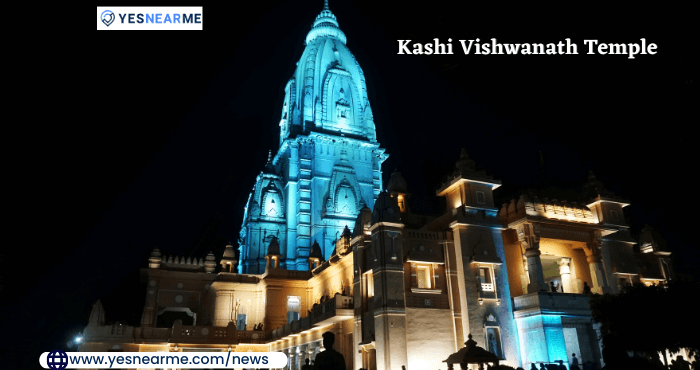




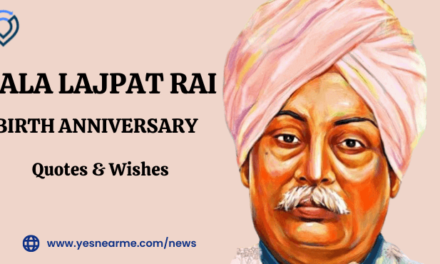
Recent Comments